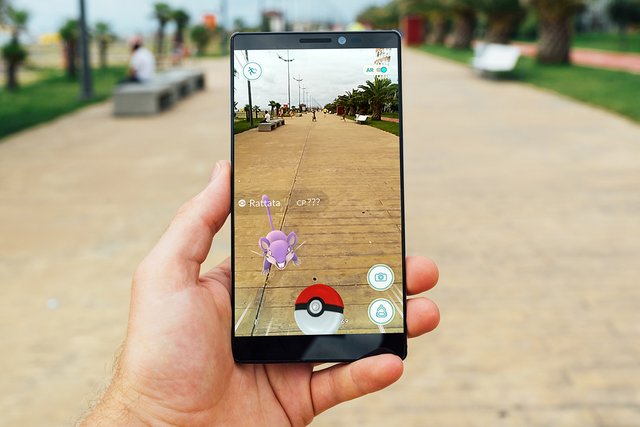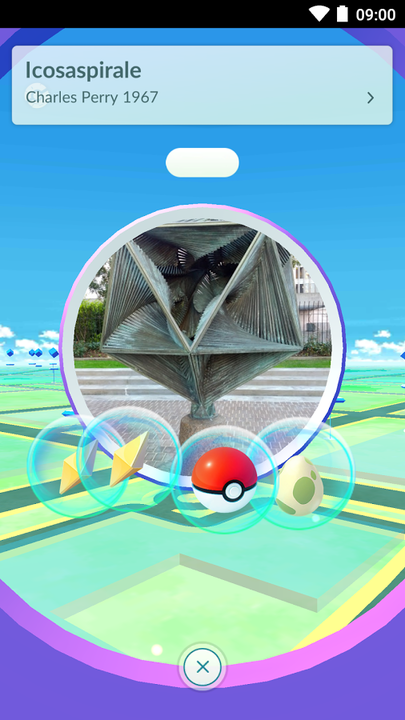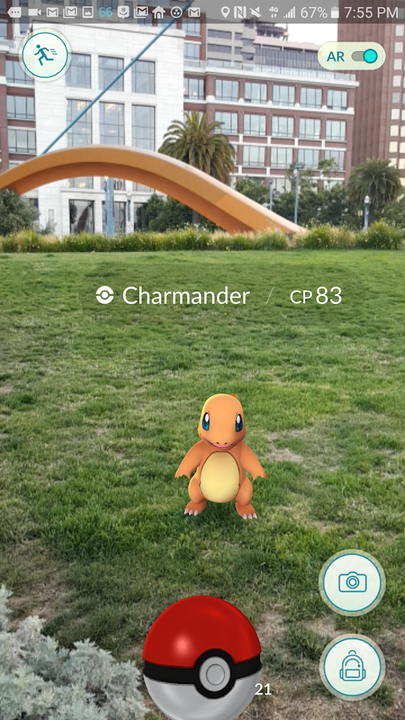A GAME DESIGNER EXPLAINS WHY ‘POKÉMON GO’ BLEW UP (AND WHAT’S NEXT)

As of this week, Pokémon Go is, by almost every measure, the most successful mobile game ever created.
In the short time since its release, the game has been installed on tens of millions of smartphones. In cities across America (and the world) millions of people are leaving their homes to play the most popular Pokémon game of all time.
As a game designer, when I see something succeeding at this level, my instinct is to try and break the game down into the individual game dynamics and technologies to see if I can figure out what the game’s developers did it right, what they did wrong, and how the particular elements that make the game so successful are resonating with players.
To figure what makes Go tick, I’ve intensely played the game myself, and analyzed how other people are interacting with this phenomenon through conversations, articles, and social media posts. Here’s why I think Niantic has been successful in creating a title that is connecting with, and delighting, players all over the world.
There is nothing like the Pokémon brand
One of the most difficult things about successfully launching a new game into the modern marketplace is letting people know that your game exists. But marketing isn’t a problem for a brand as powerful as Pokémon.
It never seems to die. Pokémania first swept the world in the 1990s, but Pokémon’s biggest years were much later. The sales of toys, cards, games, movies and more, has continued to peak year after year, long after the media hype died down. Two generations have fallen in love with its ever growing roster of adorable characters. But up until now, you had to buy a Nintendo handheld console and a cartridge that, together, would cost you a hundred dollars or more.
With the arrival of Go, Pokémon is free and will play on a device that’s already in your pocket. Whether people are playing out of nostalgia, curiosity, or hardcore fandom, the price is right for millions of fans who have been waiting for a real Pokémon game to appear on a smartphone.
But in order to take full advantage of a powerful brand you need to also play off the user’s expectations. If there’s one thing that’s core to the game’s success since the beginning, it’s the catchphrase — “Gotta Catch ’em All!” This isn’t just a slogan, it’s the fundamental set of directions for every iteration of the game. Pokémon Go may play differently from its Nintendo handheld predecessors, but this core concept remains the same.
Augmented reality is a gimmick. Movement is not
Many of claimed the game’s appeal is that it’s the first game to fully implement AR (augmented reality). Personally, I doubt that’s true. Yes, it’s a fun feature, but it’s also a gimmick.
I don’t doubt that the excitement of seeing Pokémon in the real world is driving people to check out the game, but once the initial excitement of catching a “real live” Pokémon on your street has worn off, most players will discover that it’s easier and more effective to play the game with AR turned off.
Related: Ready to become a ‘Pokémon Go’ master? Our ultimate tips guide
There is one dynamic that is deeply integrated into every aspect of the game, however — movement.
Go is a game about walking around the real world. From gathering resources at Pokéstops, to hatching eggs, to the subtle game of hide-and-go-seek you play while hunting for new creatures to put into your Pokédex, you have to walk to win.
It’s incredible to see a game that demands so much motion find a big audience. I’ve been cynical about geo-location games working outside of big cities, and up until now, I’ve been right. But Pokémon Go has broken the mold.
By Andrew Mayer — August 1, 2016 3:00 AM
pokmon go where does it from here pokemon
News from Fark
As of this week, Pokémon Go is, by almost every measure, the most successful mobile game ever created.
In the short time since its release, the game has been installed on tens of millions of smartphones. In cities across America (and the world) millions of people are leaving their homes to play the most popular Pokémon game of all time.
As a game designer, when I see something succeeding at this level, my instinct is to try and break the game down into the individual game dynamics and technologies to see if I can figure out what the game’s developers did it right, what they did wrong, and how the particular elements that make the game so successful are resonating with players.
To figure what makes Go tick, I’ve intensely played the game myself, and analyzed how other people are interacting with this phenomenon through conversations, articles, and social media posts. Here’s why I think Niantic has been successful in creating a title that is connecting with, and delighting, players all over the world.
There is nothing like the Pokémon brand
One of the most difficult things about successfully launching a new game into the modern marketplace is letting people know that your game exists. But marketing isn’t a problem for a brand as powerful as Pokémon.
It never seems to die. Pokémania first swept the world in the 1990s, but Pokémon’s biggest years were much later. The sales of toys, cards, games, movies and more, has continued to peak year after year, long after the media hype died down. Two generations have fallen in love with its ever growing roster of adorable characters. But up until now, you had to buy a Nintendo handheld console and a cartridge that, together, would cost you a hundred dollars or more.
With the arrival of Go, Pokémon is free and will play on a device that’s already in your pocket. Whether people are playing out of nostalgia, curiosity, or hardcore fandom, the price is right for millions of fans who have been waiting for a real Pokémon game to appear on a smartphone.
But in order to take full advantage of a powerful brand you need to also play off the user’s expectations. If there’s one thing that’s core to the game’s success since the beginning, it’s the catchphrase — “Gotta Catch ’em All!” This isn’t just a slogan, it’s the fundamental set of directions for every iteration of the game. Pokémon Go may play differently from its Nintendo handheld predecessors, but this core concept remains the same.
Augmented reality is a gimmick. Movement is not
Many of claimed the game’s appeal is that it’s the first game to fully implement AR (augmented reality). Personally, I doubt that’s true. Yes, it’s a fun feature, but it’s also a gimmick.
I don’t doubt that the excitement of seeing Pokémon in the real world is driving people to check out the game, but once the initial excitement of catching a “real live” Pokémon on your street has worn off, most players will discover that it’s easier and more effective to play the game with AR turned off.
Related: Ready to become a ‘Pokémon Go’ master? Our ultimate tips guide
There is one dynamic that is deeply integrated into every aspect of the game, however — movement.
Go is a game about walking around the real world. From gathering resources at Pokéstops, to hatching eggs, to the subtle game of hide-and-go-seek you play while hunting for new creatures to put into your Pokédex, you have to walk to win.
It’s incredible to see a game that demands so much motion find a big audience. I’ve been cynical about geo-location games working outside of big cities, and up until now, I’ve been right. But Pokémon Go has broken the mold.
Not only does this game get people moving, it drives people to meet face to face in shared spaces. Pokémon gyms create real-world points of contention where players can test their abilities against the most powerful players in their neighborhood.
Pokéstops provide shared resources that turn a walk down a street in a way to spot other players who are playing the game, and learn a little more about your environment.
Niantic has announced that more social features, including trading, are coming. That makes a lot of sense. After all, anything that gets players connecting and interacting is going to be good for the future of the game.
Why Pokémon Go is not as polished as its handheld brethren
As a game, Pokémon Go is a decent one. It is a B+ effort with the kind of endless playability that will maintain its popularity for a long time to come. But there are definitely design issues that I think will keep it from being the long-lived mega success that a lot of people are hoping it will be.
One of the elements that have kept the Pokémon games going strong since they first appeared has been the powerful and engaging animated aesthetic that permeates every element of the game. Oddly, other than the characters (which are definitely not as adorably cartoony here as they have been in the past) the “fun” aesthetic has been almost entirely stripped away. What’s left is an almost clinical look makes the Go feel a lot more like a demo for a science lab than a flagship title for a game company. That may be exactly what Nintendo wanted.
Not only does this game get people moving, it drives people to meet face to face in shared spaces.
As it is, the game is also almost embarrassingly simplistic. That’s great in the beginning, because it makes the game easily accessible. It also means that players can become bored when the initial novelty wears off.
Niantic may be able to create a deeper combat experience that allows players to spend more time in the game without having to run around so much. But with the core of the game so dedicated to motion, that I wonder if that’s even possible.
And Nintendo probably wants players looking for a deeper game experience to go buy a cartridge. By making this game a simpler echo of its “main” titles, I believe they hoped it would drive players to grab the latest handheld console to play the latest version of the game they loved as kids.
Related: Dear idiots: Stop ruining ‘Pokémon Go’ with all your nonsense
But it seems as if a wave of pure nostalgia and the innate iconic power of the core characters has overcome Nintendo’s attempt to channel the power of its own brand.
Pokémon Go will sell some 3DS consoles, but I’m dubious that more than a fraction of Pokémon Go players will convert to console gamers. Then again, given the current numbers of people playing, a fraction may be more than enough to make the next Pokémon cartridge game the biggest ever.
Go is riddled with bugs and monetization problems
Another issue that may slow down the hype is that the game is buggy as hell. It crashes, it freezes, it slows down, and servers get overloaded every day at lunch and dinnertime.
A big part of that is clearly because Niantic wasn’t ready for this level of success. (Who could be?) But those aren’t game’s only problem; by overlaying the virtual world over the actual world, Niantic has crashed straight into some of the biggest challenges in multiplayer design, including user database updates, economic balancing, and network infrastructure. Things will no doubt get better, and I’m guessing that some of its problems will simply vanish the initial flood of users begins to ebb to a more manageable level.


Which leads to another issue: it isn’t clear exactly what Niantic is considering to be its measure of success. Sure, the game is making tons of cash right now, but the monetization model is very passive for a free-to-play game of this type. While that may make players happy, it also means that it will be really difficult to add any new monetization features going forward. That’s because when something you pay for becomes free, it feels like a gift, but when you start charging for something that’s free, people treat it like stealing. There’s no way I can imagine Niantic will be able to get people to pay to unlock new Pokémon, for example.
But it will need to add new features if it hopes to hold onto more than a fraction of audience.
Where does Pokémon go from here?
One thing I’m sure of is that it’s mathematically impossible to sustain the level of growth we’ve seen over the last couple of weeks.
And just like in Westeros, “winter is coming!” With all the walking it takes to catch monsters, you won’t kids playing on every street-corner once school starts and the days begin getting shorter and colder.
Pokémon Go is, by almost every measure, the most successful mobile game ever created.
But maybe that isn’t the point. When Pokémon are involved, all bets are off in terms of what’s next. And when a new game captures lightning in a bottle, it’s a great opportunity for game designers to watch and learn from what the developers do with all that light and power. I did with Pokémon 20 years ago, and I’m doing it again today.
The success of Pokémon Go has given Niantic has a huge opportunity to try out new ideas. And maybe it has a plan to take its success to the next level. I’m very curious to see what the game looks like a year from now, and if Nintendo will get more involved.
Meanwhile, these adorable monsters have, for a second or third time, shifted the direction of mobile gaming. Maybe, just maybe, Pokémon Go can become the very best Pokémon game of all — the best there ever was.
Upvoted
Hi! This post has a Flesch-Kincaid grade level of 9.1 and reading ease of 69%. This puts the writing level on par with Michael Crichton and Mitt Romney.